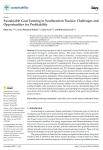Day R., Mohamed-Brahmi A., Aribi F., Jaouad M. (2025). Sustainable goat farming in Southeastern Tunisia: challenges and opportunities for profitability. Sustainability, 02/04/2025, vol. 17, n. 8, p. 3669.
https://doi.org/10.3390/su17083669
https://doi.org/10.3390/su17083669
| Titre : | Sustainable goat farming in Southeastern Tunisia: challenges and opportunities for profitability (2025) |
| Auteurs : | R. Day ; A. Mohamed-Brahmi ; F. Aribi ; M. Jaouad |
| Type de document : | Article |
| Dans : | Sustainability (vol. 17, n. 8, April 2025) |
| Article en page(s) : | p. 3669 |
| Langues : | Anglais |
| Langues du résumé : | Anglais |
| Catégories : |
Catégories principales 06 - AGRICULTURE. FORÊTS. PÊCHES ; 6.4 - Production Agricole. Système de ProductionThésaurus IAMM CHEVRE ; CAPRIN ; ELEVAGE ; PRODUCTION ANIMALE ; SECURITE ALIMENTAIRE ; PATRIMOINE CULTUREL ; TUNISIE |
| Résumé : | Goat farming represents a critical component of rural livelihoods, food security, and cultural heritage in southeastern Tunisia. This study adopts a multi-stakeholder approach to analyze the goat value chain in Tataouine, incorporating focus groups, semi-structured questionnaires, and direct observations with 80 farmers, 3 veterinarians, 13 butchers, and 100 consumers. The findings reveal strong local demand, with 72% of consumers purchasing goat meat and 66% consuming milk. However, significant inefficiencies exist, particularly a misalignment between production and market requirements: while 92% of butchers prefer fattened animals, only 16% of farmers engage in fattening practices. Women constitute 49% of dairy processors, yet face persistent resource constraints. Climate pressures exacerbate these challenges, with 80% of farmers reporting water scarcity and 93.8% observing pasture degradation. Three strategic interventions emerge as pivotal for sustainable development: targeted support for feed-efficient fattening techniques, establishment of women-led dairy processing collectives, and implementation of climate-resilient water management systems. These measures address core constraints while leveraging existing strengths of the production system. The study presents a transferable framework for livestock value chain analysis in arid regions, demonstrating how integrated approaches can enhance both economic viability and adaptive capacity while preserving traditional pastoral systems. |
| Cote : | En ligne |
| URL / DOI : | https://doi.org/10.3390/su17083669 |







